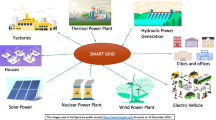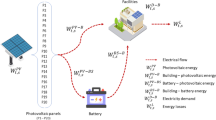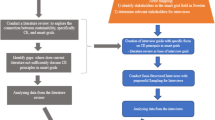Abstract
Market power is a dominant feature of many modern electricity markets with an oligopolistic structure, resulting in increased consumer cost. This work investigates how consumers, through demand response (DR), can mitigate against market power. Within DR, our analysis particularly focusses on the impacts of load shifting and self-generation. A stochastic mixed complementarity problem is presented to model an electricity market characterised by an oligopoly with a competitive fringe. It incorporates both energy and capacity markets, multiple generating firms and different consumer types. The model is applied to a case study based on data for the Irish power system. The results demonstrate how DR can help consumers mitigate against the negative effects of market power and that load shifting and self-generation are competing technologies, whose effectiveness against market power is similar for most consumers. We also find that DR does not necessarily reduce emissions in the presence of market power.










Similar content being viewed by others
Notes
There are many types of renewable support schemes. In this work, we consider a constant feed-in premium, i.e. when generators use renewable sources to generate electricity, they receive the market price plus a fixed premium (per MWh). We refer the reader to Devine et al. (2017) for a detailed discussion on different renewable support schemes.
The derating factor in this work reflects the proportion of its overall capacity a technology can provide to meet the capacity target.
In an Irish context, these efficiencies may lead to existing baseload generation having higher variable power generation costs than existing mid-merit generators.
We acknowledge that the exact quantitative results would differ when assuming different (higher) fuel prices. The qualitative findings, however, would largely remain the same. A quantitative sensitivity analysis for fuel prices would go beyond the scope of the paper but could be part of future research specifically focusing on the effects of fuel prices during periods with price shocks.
All values for \(\mathrm{NORM}^{\text {G}}_{f,t,p,s}\) and \(\mathrm{NORM}^{\text {PV}}_{p,s}\) are provided in the online appendix: https://figshare.com/articles/dataset/inputs_Devine_Bertsch_2022/19947842. The values for \(\mathrm{NORM}^{\text {G}}_{f,t,p,s}\) are split into three different wind regions in Ireland - see Bertsch et al. (2018) for details.
Note that these consumer costs only include the directly market-related costs, i.e. they do not incorporate the levies end consumers have to pay resulting from feed-in premium payments to renewable generators.
In addition to costs calculated via Eq. (5a), the costs in Fig. 9 also account for costs consumers would have to pay in order to facilitate capacity payments. We assume capacity payment costs are spread proportionally amongst consumers according to their peak demand. Accounting for capacity payment costs is in contrast to the rest of the paper where consumer costs are solely calculated via Eq. (5a) as capacity payments costs are not relevant.
Note that constraint (5i) is only binding in the cases with market power and in these cases, it is only ever binding for consumer groups 2 and 5, i.e. those consumers with micro generation.
References
Albadi MH, El-Saadany E (2008) A summary of demand response in electricity markets. Electric Power Syst Res 78(11):1989–1996
Allcott H (2011) Rethinking real-time electricity pricing. Resour Energy Econ 33(4):820–842
Ambec S, Crampes C (2012) Electricity provision with intermittent sources of energy. Resour Energy Econ 34(3):319–336
Baltensperger T, Füchslin RM, Krütli P, Lygeros J (2016) Multiplicity of equilibria in conjectural variations models of natural gas markets. Eur J Oper Res 252(2):646–656
Bertsch V, Devine MT, Sweeney C, Parnell AC (2018) Analysing long-term interactions between demand response and different electricity markets using a stochastic market equilibrium model, ESRI working paper http://esri.ie
Bertsch V, Geldermann J, Lühn T (2017) What drives the profitability of household PV investments, self-consumption and self-sufficiency? Appl Energy 204:1–15
Blumsack S, Perekhodtsev D, Lave LB (2002) Market power in deregulated wholesale electricity markets: issues in measurement and the cost of mitigation. Electr J 15(9):11–24
Borenstein S, Bushnell J (1999) An empirical analysis of the potential for market power in California’s electricity industry. J Ind Econ 47(3):285–323
Bosilovich MG, Lucchesi R, Suarez M (2016) MERRA-2: file Specification. GMAO Office Note, 1–73 No.9 (Version 1.1). http://gmao.gsfc.nasa.gov/pubs/office_notes
Burger S, Chaves-Ávila JP, Batlle C, Pérez-Arriaga IJ (2017) A review of the value of aggregators in electricity systems. Renew Sustain Energy Rev 77:395–405
Cannon D, Brayshaw D, Methven J, Coker P, Lenaghan D (2015) Using reanalysis data to quantify extreme wind power generation statistics: a 33 year case study in Great Britain. Renew Energy 75:767–778
Caves D, Eakin K, Faruqui A (2000) Mitigating price spikes in wholesale markets through market-based pricing in retail markets. Electr J 13(3):13–23
Comission for Energy Regulation (2014) CER national smart metering programme smart metering high level design. Available online: http://www.cer.ie/docs/000699/CER14046%20High%20Level%20Design.pdf
Cradden LC, McDermott F, Zubiate L, Sweeney C, O’Malley M (2017) A 34-year simulation of wind generation potential for Ireland and the impact of large-scale atmospheric pressure patterns. Renew Energy 106:165–176
Dalton JC et al (1997) Assessing the competitiveness of restructured generation. Electr J 10(3):30–39
David AK, Wen F (2001) Market power in electricity supply. IEEE Trans Energy Convers 16(4):352–360
De Jonghe C, Hobbs BF, Belmans R (2012) Optimal generation mix with short-term demand response and wind penetration. IEEE Trans Power Syst 27(2):830–839
de Maere d’Aertrycke G, Ehrenmann A, Ralph D, Smeers Y et al (2017) Risk trading in capacity equilibrium models. Tech. rep. JSTOR
Devine MT, Bertsch V (2018) Examining the benefits of load shedding strategies using a rolling-horizon stochastic mixed complementarity equilibrium model. Eur J Oper Res 267(2):643–658
Devine MT, Farrell N, Lee WT (2017) Optimising feed-in tariff design through efficient risk allocation. Sustain Energy Grids Netw 9:59–74
Devine MT, Gabriel SA, Moryadee S (2016) A rolling horizon approach for stochastic mixed complementarity problems with endogenous learning: application to natural gas markets. Computers Oper Res 68:1–15
Devine MT, Nolan S, Lynch MÁ, O’Malley M (2019) The effect of demand response and wind generation on electricity investment and operation. Sustain Energy Grids Netw 17:100190
Devine MT, Siddiqui S (2020) Modelling an electricity market oligopoly with a competitive fringe and generation investments arXiv preprint arXiv:2001.03526
Egging R, Gabriel SA, Holz F, Zhuang J (2008) A complementarity model for the European natural gas market. Energy Policy 36(7):2385–2414
Egging R, Holz F (2016) Risks in global natural gas markets: investment, hedging and trade. Energy Policy 94:468–479
EirGrid (2017) All-island generation capacity statement 2017–2026
Farrell N, Devine MT, Lee WT, Gleeson JP, Lyons S (2017) Specifying an efficient renewable energy feed-in tariff. Energy J 38(2):53–76
Feuerriegel S, Neumann D (2016) Integration scenarios of demand response into electricity markets: load shifting, financial savings and policy implications. Energy Policy 96:231–240
Gabriel SA, Conejo AJ, Fuller JD, Hobbs BF, Ruiz C (2012) Complementarity modeling in energy markets, vol 180. Springer, New York
Gabriel SA, Kiet S, Zhuang J (2005) A mixed complementarity-based equilibrium model of natural gas markets. Oper Res 53(5):799–818
Gérard H, Leclère V, Philpott A (2018) On risk averse competitive equilibrium. Oper Res Lett 46(1):19–26
Gönsch J, Hassler M (2016) Sell or store? an adp approach to marketing renewable energy. OR Spectrum 38(3):633–660
Good N, Ellis KA, Mancarella P (2017) Review and classification of barriers and enablers of demand response in the smart grid. Renew Sustain Energy Rev 72:57–72
Green RJ, Newbery DM (1992) Competition in the British electricity spot market. J Polit Econ 100(5):929–953
Grigg C (1996) The IEEE reliability test system: 1996. In: Paper 96 WM 326-9 PWRS, IEEE Winter power meeting 1996 IEEE
Haftendorn C, Holz F (2010) Modeling and analysis of the international steam coal trade. Energy J 31(4):205–229
Hobbs B (2001) Linear complementarity models of Nash-Cournot competition in bilateral and POOLCO power markets. IEEE Trans Power Syst 16(2):194–202
Hobbs BF, Metzler CB, Pang J-S (2000) Strategic gaming analysis for electric power systems: an mpec approach. IEEE Trans Power Syst 15(2):638–645
Hu M-C, Lu S-Y, Chen Y-H (2016) Stochastic-multiobjective market equilibrium analysis of a demand response program in energy market under uncertainty. Appl Energy 182:500–506
Huppmann D (2013) Endogenous production capacity investment in natural gas market equilibrium models. Eur J Oper Res 231(2):503–506
Huppmann D, Egging R (2014) Market power, fuel substitution and infrastructure-a large-scale equilibrium model of global energy markets. Energy 75:483–500
Karthikeyan SP, Raglend IJ, Kothari DP (2013) A review on market power in deregulated electricity market. Int J Electric Power Energy Syst 48:139–147
Koschker S, Möst D (2016) Perfect competition vs strategic behaviour models to derive electricity prices and the influence of renewables on market power. OR Spectrum 38(3):661–686
Lee C-Y (2016) Nash-profit efficiency: a measure of changes in market structures. Eur J Oper Res 255(2):659–663
Li T, Shahidehpour M (2005) Strategic bidding of transmission-constrained gencos with incomplete information. IEEE Trans Power Syst 20(1):437–447
Lynch M, Devine MT, Bertsch V (2019) The role of power-to-gas in the future energy system: market and portfolio effects. Energy 185:1197–1209
Lynch MÁ, Devine MT (2017) Investment vs. refurbishment: examining capacity payment mechanisms using mixed complementarity problems with endogenous probability. Energy J 38(2):27–51
Moser E, Grass D, Tragler G (2016) A non-autonomous optimal control model of renewable energy production under the aspect of fluctuating supply and learning by doing. OR Spectrum 38(3):545–575
Neuhoff K, Barquin J, Boots MG, Ehrenmann A, Hobbs BF, Rijkers FA, Vazquez M (2005) Network-constrained cournot models of liberalized electricity markets: the devil is in the details. Energy Econ 27(3):495–525
Ofgem (2013) Electricity capacity assessment report 2013. Tech rep, Ofgem https://www.ofgem.gov.uk/ofgem-publications/75232/electricity-capacity-assessment-report-2013-pdf
Philpott A, Ferris M, Wets R (2016) Equilibrium, uncertainty and risk in hydro-thermal electricity systems. Math Program 157(2):483–513
Pozo D, Sauma E, Contreras J (2017) Basic theoretical foundations and insights on bilevel models and their applications to power systems. Ann Oper Res 254(1–2):303–334
Ruppert M, Bertsch V, Fichtner W (2015) Optimal load shedding in distributed networks with sigmoid cost functions. In: 2015 International Symposium on Smart Electric Distribution Systems and Technologies (EDST) IEEE, pp 159–164
Ruppert M, Hayn M, Bertsch V, Fichtner W (2016) Impact of residential electricity tariffs with variable energy prices on low voltage grids with photovoltaic generation. Int J Electric Power Energy Syst 79:161–171
Russo M, Kraft E, Bertsch V, Keles D (2022) Short-term risk management of electricity retailers under rising shares of decentralized solar generation. Energy Econ 109:105956
Schwarz H, Bertsch V, Fichtner W (2018) Two-stage stochastic, large-scale optimization of a decentralized energy system: a case study focusing on solar PV, heat pumps and storage in a residential quarter. OR Spectrum 40(1):265–310
Shafie-Khah M, Shoreh M, Siano P, Fitiwi D, Godina R, Osorio G, Lujano-Rojas J, Catalao J (2016) Optimal demand response programs for improving the efficiency of day-ahead electricity markets using a multi attribute decision making approach. In: 2016 IEEE International Energy Conference (ENERGYCON) IEEE, pp 1–6
Su C-L, Kirschen D (2009) Quantifying the effect of demand response on electricity markets. IEEE Trans Power Syst 24(3):1199–1207
Walawalkar R, Blumsack S, Apt J, Fernands S (2008) An economic welfare analysis of demand response in the PJM electricity market. Energy Policy 36(10):3692–3702
Wozabal D, Graf C, Hirschmann D (2016) The effect of intermittent renewables on the electricity price variance. OR Spectrum 38(3):687–709
Ye Y, Papadaskalopoulos D, Strbac G (2017) Investigating the ability of demand shifting to mitigate electricity producers’ market power. IEEE Trans Power Syst 33(4):3800–3811
Zarnikau J, Hallett I (2008) Aggregate industrial energy consumer response to wholesale prices in the restructured Texas electricity market. Energy Econ 30(4):1798–1808
Zarnikau JW (2010) Demand participation in the restructured electric reliability council of Texas market. Energy 35(4):1536–1543
Zivin JSG, Kotchen MJ, Mansur ET (2014) Spatial and temporal heterogeneity of marginal emissions: implications for electric cars and other electricity-shifting policies. J Econ Behav Organ 107:248–268
Acknowledgements
Devine acknowledges funding from Science Foundation Ireland (SFI) under the SFI Strategic Partnership Programme Grant number SFI/15/SPP/E3125. The opinions, findings and conclusions or recommendations expressed in this material are those of the authors and do not necessarily reflect the views of the Science Foundation Ireland. Bertsch acknowledges funding from the ESRI’s Energy Policy Research Center. All omissions and errors are our own.
Author information
Authors and Affiliations
Corresponding author
Ethics declarations
Conflict of interest
The authors declare that they have no known conflicts of interest relating to this paper.
Additional information
Publisher's Note
Springer Nature remains neutral with regard to jurisdictional claims in published maps and institutional affiliations.
A. Karush-Kuhn-Tucker conditions
A. Karush-Kuhn-Tucker conditions
This appendix presents the Karush-Kuhn-Tucker (KKT) conditions for optimality for the two types of players modelled in this work. These conditions, along with the market clearing conditions (8), make up the mixed complementarity problem. The “perp” notation \(0 \le a \perp b \ge 0\) is equivalent to \(a\ge 0\), \(b\ge 0\) and \(a.b=0\).
1.1 A.1 Firms’ KKT conditions
The firms’ KKT conditions are
If firm f is a price-making firm, then it’s optimal level of generation for technology t, using equation (10a), is
1.2 A.2 Consumers’ KKT conditions
The consumers’ KKT conditions are
where
Rights and permissions
Springer Nature or its licensor (e.g. a society or other partner) holds exclusive rights to this article under a publishing agreement with the author(s) or other rightsholder(s); author self-archiving of the accepted manuscript version of this article is solely governed by the terms of such publishing agreement and applicable law.
About this article
Cite this article
Devine, M.T., Bertsch, V. The role of demand response in mitigating market power: a quantitative analysis using a stochastic market equilibrium model. OR Spectrum 45, 555–597 (2023). https://doi.org/10.1007/s00291-022-00700-0
Received:
Accepted:
Published:
Issue Date:
DOI: https://doi.org/10.1007/s00291-022-00700-0




